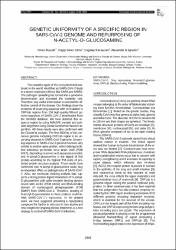| dc.contributor.author | Baysal, Ömür | |
| dc.contributor.author | Silme, Ragıp Soner | |
| dc.contributor.author | Karaaslan, Çağatay | |
| dc.contributor.author | Ignatov, Alexander N. | |
| dc.date.accessioned | 2021-04-15T11:47:55Z | |
| dc.date.available | 2021-04-15T11:47:55Z | |
| dc.date.issued | 2021 | en_US |
| dc.identifier.uri | https://hdl.handle.net/20.500.12809/9170 | |
| dc.description.abstract | The causative agent of the viral pneumonia outbreak in the world identified as SARS-CoV-2 leads to a severe respiratory illness like SARS and MERS. The pathogen spreading has turned into a pandemic dissemination and increased the mortality rate. Therefore, any useful information is essential for effective control of the disease. Our findings show the existence of unvarying sequence with no mutation in ORF lab regions from 134 high-quality filtered genome sequences of SARS-CoV-2 downloaded from the GISAID database. We have detected this sequence region by using MAUVE analysis and pairwise alignment using Global Needleman Wunsch algorithm. All these results were also confirmed with the Clustal W analysis. The first 6500 bp of the consensus genome including ORF lab region is an unvarying sequence in SARS-CoV-2 genome. Unvarying sequence in SARS-CoV-2 genome has been very similar to another spike protein, which belongs to feline infectious peritonitis virus strain UU4 (PDB 6JX7), depending on amino acid sequences encoded, and N-acetyl-D-glucosamine is the ligand of this protein according to the highest TM-score of predicted protein structure analysis. These results have confirmed that N-acetyl-D-glucosamine could play an important effect on pathogenicity of SARS-CoV-2. Also, our molecular docking analysis data supports a strong protein-ligand interaction of N-acetyl-D-glucosamine with spike receptor-binding domain bound with ACE2 (PDB 6M0J) and RNA-binding domain of nucleocapsid phosphoprotein (PDB 6WKP) from SARS-CoV-2. Therefore, binding of N-acetyl-D-glucosamine to these proteins could inhibit SARS-CoV-2's replication. In the present work, we have suggested providing a repurposing compound for further in vitro and in vivo studies and new insights for ongoing clinical treatments as a new strategy to control of SARS-CoV-2 infections. | en_US |
| dc.item-language.iso | eng | en_US |
| dc.publisher | PARLAR SCIENTIFIC PUBLICATIONS (P S P) | en_US |
| dc.item-rights | info:eu-repo/semantics/openAccess | en_US |
| dc.subject | SARS-CoV-2 | en_US |
| dc.subject | Drug repurposing | en_US |
| dc.subject | N-acetyl-D-glucosa-mine | en_US |
| dc.subject | ORF1ab | en_US |
| dc.subject | Biodata mining | en_US |
| dc.subject | Protein modelling | en_US |
| dc.title | GENETIC UNIFORMITY OF A SPECIFIC REGION IN SARS-CoV-2 GENOME AND REPURPOSING OF N-ACETYL-D-GLUCOSAMINE | en_US |
| dc.item-type | article | en_US |
| dc.contributor.department | MÜ, Fen Fakültesi, Moleküler Biyoloji ve Genetik Bölümü | en_US |
| dc.contributor.authorID | 0000-0001-5104-0983 | en_US |
| dc.contributor.institutionauthor | Baysal, Ömür | |
| dc.identifier.volume | 30 | en_US |
| dc.identifier.issue | 3 | en_US |
| dc.identifier.startpage | 2848 | en_US |
| dc.identifier.endpage | 2857 | en_US |
| dc.relation.journal | Fresenius Environmental Bulletin | en_US |
| dc.relation.publicationcategory | Makale - Uluslararası Hakemli Dergi - Kurum Öğretim Elemanı | en_US |


















